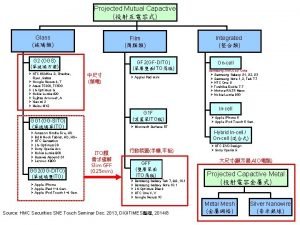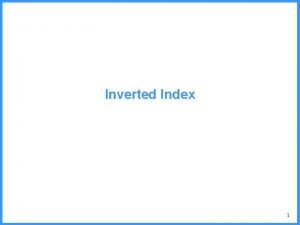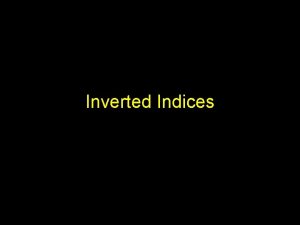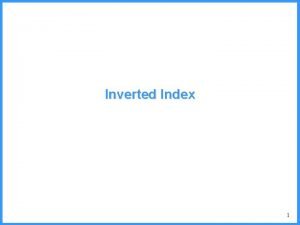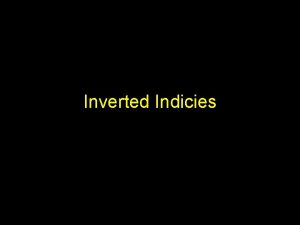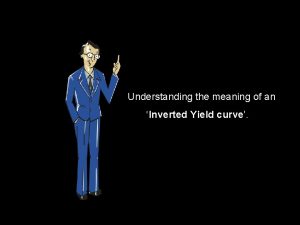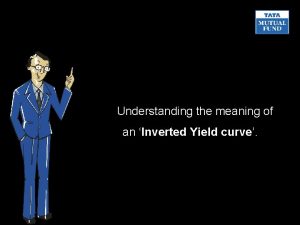FEDYIELD TAPERING INVERTED CURVE Understanding The meaning of
















- Slides: 16

FEDYIELD TAPERING INVERTED CURVE

Understanding The meaning of an ‘Inverted Yield curve’.

INVERTED YIELD CURVE The "Yield Curve” is a graphical representation of interest rates on securities of different maturities, ranging from short to longest tenure bonds.

INVERTED YIELD CURVE This is how the “Normal Yield Curve” typically looks like. R a t e s Maturity http: //simplysimple. in/

INVERTED YIELD CURVE In a typical yield curve scenario, a lender would charge a lower interest if he lends for a shorter time period and higher interest for a longer term loan. This is because he takes a bigger risk for a longer period as he is not too sure what would be the state of the borrower over a longer term.

INVERTED YIELD CURVE However over the shorter term he does not mind charging a smaller rate of interest as he is more confident of the state of the borrower in the short run.

INVERTED YIELD CURVE So what is an “Inverted Yield curve”? R a t e s Maturity

INVERTED YIELD CURVE As seen in the diagram, an inverted Yield Curve is a representation of a specific scenario in the market wherein the short term interest rates are higher than the long term interest rates. Why does this happen?

INVERTED YIELD CURVE This happens due to a tight liquidity environment when money supply is inadequate. For e. g. Sometimes organizations have to borrow at a high cost to meet their working capital needs to support their operating expenses which is vital for the day to day running of an organization.

INVERTED YIELD CURVE Hence in moments of tight liquidity when companies need money badly to run their operations, they are open to paying higher in the short run than what is prevailing for long term borrowing.

INVERTED YIELD CURVE Another reason that can be attributed to the inverted shape of the Yield Curve is the pessimistic expectation of the economy in the medium to long term. If people feel that the policies of the government will be unable to push growth then the propensity for long term investments reduce which brings down the demand for long term borrowing which in turn brings down the long term rate of interest.

INVERTED YIELD CURVE However these kind of situations ease out over a period of time as liquidity and expectations improve and the “Inverted Yield Curve” reverts to its original state to become a ‘Normal Yield Curve’. This is known as “Steepening” of the Yield Curve.

INVERTED YIELD CURVE Hope you got an idea about the Yield Curve and the “Inverted Yield Curve” through this lesson

INVERTED YIELD CURVE Hope you have understood The significance of the “Inverted Yield Curve”

Please give us your feedback at professor@tataamc. com

DISCLAIMER The views expressed in this lesson are for information purposes only and do not construe to be any investment, legal or taxation advice. The lesson is a conceptual representation and may not include several nuances that are associated and vital. The purpose of this lesson is to clarify the basics of the concept so that readers at large can relate and thereby take more interest in the product / concept. In a nutshell, Professor Simply Simple lessons should be seen from the perspective of it being a primer on financial concepts. The contents are topical in nature and held true at the time of creation of the lesson. This is not indicative of future market trends, nor is Tata Asset Management Ltd. attempting to predict the same. Reprinting any part of this material will be at your own risk. Tata Asset Management Ltd. will not be liable for the consequences of such action. Mutual Fund investments are subject to market risks, read all scheme related documents carefully.
 Spiral angle of bur
Spiral angle of bur Tpn tapering guidelines
Tpn tapering guidelines Hedging with forward contracts
Hedging with forward contracts Tapering fed
Tapering fed Tapering qe
Tapering qe Change curve+awareness+understanding+acceptance+commitment
Change curve+awareness+understanding+acceptance+commitment Inverted pyramid definition
Inverted pyramid definition Example of inverted commas
Example of inverted commas Hyperbolic and sigmoidal curve
Hyperbolic and sigmoidal curve S curve and j curve
S curve and j curve Antimonson curve
Antimonson curve J curve vs s curve
J curve vs s curve Hát kết hợp bộ gõ cơ thể
Hát kết hợp bộ gõ cơ thể Bổ thể
Bổ thể Tỉ lệ cơ thể trẻ em
Tỉ lệ cơ thể trẻ em Chó sói
Chó sói



